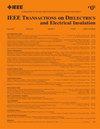Application of PDC Testing for Medium-Voltage XLPE Cable Joint Water Ingress Detection
IF 2.9
3区 工程技术
Q2 ENGINEERING, ELECTRICAL & ELECTRONIC
IEEE Transactions on Dielectrics and Electrical Insulation
Pub Date : 2024-12-27
DOI:10.1109/TDEI.2024.3523877
引用次数: 0
Abstract
This article took 6.6-kV medium-voltage crosslinked polyethylene (XLPE) cables as the test object, conducting field tests of polarization and depolarization currents (PDCs), very-low-frequency (VLF) tanPDC试验在中压交联聚乙烯电缆接头进水检测中的应用
本文以6.6 kv中压交联聚乙烯(XLPE)电缆为试验对象,进行了极化和去极化电流(PDCs)、甚低频(VLF) tan $\delta $和时域反射(TDR)的现场试验。为了提高PDC测试方法的有效性,研究了PDC测试与VLF tan $\delta $和TDR测量之间的相关性。PDC测试结果表明,随着时间的推移,极化电流有时会表现出增加或非单调的趋势,在本文中称为异常趋势。通过深入研究,结合TDR测量结果和相关理论框架,确认了电缆接头进水问题是导致极化电流异常的原因。水进入节理后,节理绝缘电导率随电场的非线性变化,表现为节理绝缘界面极化电流的异常趋势。这类异常极化电流可作为识别电缆接头问题的有效诊断指标。此外,单独的VLF tan \delta有时无法准确诊断电缆接头的进水问题,因此需要使用TDR进行进一步诊断。
本文章由计算机程序翻译,如有差异,请以英文原文为准。
求助全文
约1分钟内获得全文
求助全文
来源期刊
CiteScore
6.00
自引率
22.60%
发文量
309
审稿时长
5.2 months
期刊介绍:
Topics that are concerned with dielectric phenomena and measurements, with development and characterization of gaseous, vacuum, liquid and solid electrical insulating materials and systems; and with utilization of these materials in circuits and systems under condition of use.

 求助内容:
求助内容: 应助结果提醒方式:
应助结果提醒方式:


